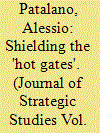| Srl | Item |
| 1 |
ID:
085100


|
|
|
|
|
| Publication |
2008.
|
| Summary/Abstract |
Long understood as the key document in Britain's Cold War history, the Duncan Sandys Defence White Paper of 1957 nevertheless has a largely forgotten context: home defence. This article argues that understanding this context allows important new conclusions to be drawn concerning the drafting, presentation and the reception of the document and the deterrent strategy it expounded. It argues that the Paper failed to establish a new doctrine for civil defence which reconciled the policy with the wider deterrent strategy. In doing this, the Paper presented a muddled policy to the public: one which failed to justify the reductions in civil defence provision but which stressed the destructive power of thermonuclear weapons. This had the effect of encouraging the critics of the government's nuclear strategy to flag up the absence of adequate civil defence measures and highlight the 'admission' that there was no defence against the hydrogen bomb.
|
|
|
|
|
|
|
|
|
|
|
|
|
|
|
|
| 2 |
ID:
085097


|
|
|
|
|
| Publication |
2008.
|
| Summary/Abstract |
This article examines the key lessons of combining diplomacy and airpower in the Kosovo Crisis (1998-99). Drawing on a comprehensive list of primary sources involved in the military leadership of NATO at the time, this article goes beyond existing literature in revealing just how surprisingly unprepared NATO was when it went to war against the Federal Republic of Yugoslavia (FRY). This article argues that on the eve of war, NATO neither had a political nor a military strategy for handling the war it itself had started - and that at the time, the air power community in general failed to appreciate the need for producing more precise and innovative solutions to complex conflicts and crises in the lower band of the intensity spectrum.
|
|
|
|
|
|
|
|
|
|
|
|
|
|
|
|
| 3 |
ID:
085099


|
|
|
|
|
| Publication |
2008.
|
| Summary/Abstract |
The purpose of this article is to analyse British strategic nuclear targeting between 1974 and 1979, prior to the successful completion of the sophisticated modification to Polaris submarine-missile system codenamed Chevaline. It will use as its starting point the parameters for UK strategic nuclear targeting, and the foundation of the 'Moscow Criterion', prior to the deployment of Britain's Polaris submarines which began in 1968. It will then discuss the recommendation by the Chiefs of Staff to retarget Polaris in 1975/76 and the implications of that recommendation in terms of the British approach to strategic nuclear deterrence. The article will conclude with an assessment of these retargeting decisions on the decision to replace Polaris with the US Trident system in 1980.
|
|
|
|
|
|
|
|
|
|
|
|
|
|
|
|
| 4 |
ID:
085098


|
|
|
|
|
| Publication |
2008.
|
| Summary/Abstract |
The build-up of Japan's military apparatus in the 1990s and 2000s has been often regarded by security analysts as indicative of a departure from the country's Cold War strategic posture. Japan appears to be engaged in a process of militarisation that is eroding the foundations of its 'exclusively defence-oriented' policy. In the case of the archipelago's naval strategy, such assessments overlook the longstanding significance of a core feature of its defence policy, namely the surveillance of maritime crossroads delivering the wealth of the country. The paper reassesses the evolution of the Japanese strategy since the Cold War by examining the development of the Japanese Maritime Self-Defence Force's submarine force, one of the key components of the defensive shield for these crossroads. The paper argues that with the changes in the security environment of the 1990s, Japan already fielded a mature force with state-of-the-art submarines, and that the rise of a new naval competitor aiming at controlling key strategic points along Japan's sea lanes reconfirmed the critical importance of submarine operations to Japanese national security
|
|
|
|
|
|
|
|
|
|
|
|
|
|
|
|
| 5 |
ID:
085102


|
|
|
|
|
| Publication |
2008.
|
| Summary/Abstract |
In modern warfare at and from the sea, logistics are crucially important to the implementation of strategy and conduct of operational campaigns. Between August 1943 and March 1944, a British joint service mission led by Major-General John Lethbridge travelled to North America, the Pacific, and India to study the organisation, equipment, and methods necessary for coming offensive operations against Japan. The British obtained valuable information from the Americans and connected with those countries of the British Empire most directly involved. The Lethbridge Mission's progress and findings informed evolving Admiralty planning for supporting naval forces to be sent to the Indian and Pacific Oceans in pursuance of British wartime strategy.
|
|
|
|
|
|
|
|
|
|
|
|
|
|
|
|